Using the Premium File Transfer Task
The Premium File Transfer Task is used to transfer files in addition to performing basic file system tasks. There are four main pages that can be configured:
- General
- Advanced Filtering
- Property Mappings
- Error Handling
General Page
The General page can be used to configure some general settings in the Premium File Transfer Task.
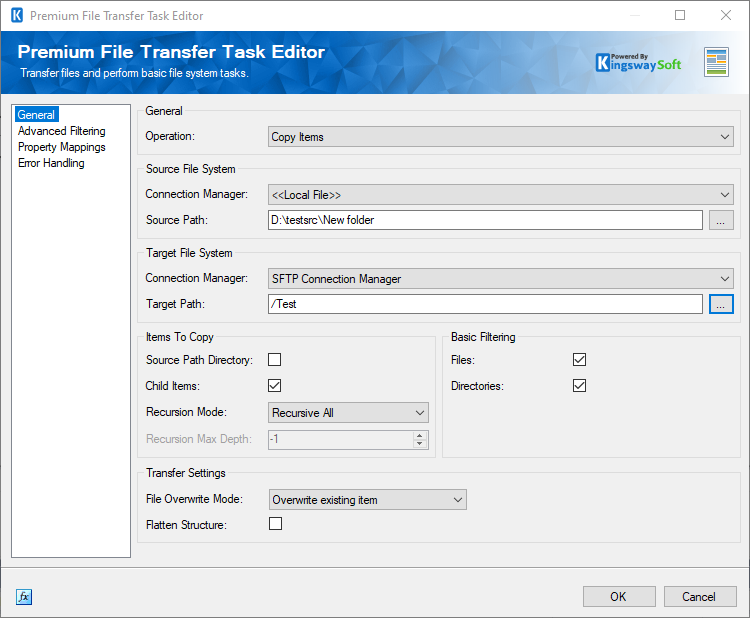
The Premium File Transfer Task Component requires a connection in order to connect to files or folder structures. The Connection Manager drop-down will show a list of all connection managers that are available to your current SSIS package.
This component will support the following connection managers:
-
- Local File
- FTPS Connection Manager
- SFTP Connection Manager
- Amazon S3 Connection Manager(since v6.0)
- Azure Blob Connection Manager(since v6.0)
- Azure Data Lake Storage Connection Manager(since v10.0)
- Azure Files Connection Manager(since v20.1)
- Box Connection Manager
- Dropbox Connection Manager
- Google Cloud Storage Connection Manager(since v9.0)
- Google Drive Connection Manager(since v21.2)
- Hadoop Connection Manager(since v10.0)
- OneDrive Connection Manager
- SharePoint Connection Manager (offered with the SSIS Integration Toolkit for Microsoft SharePoint)
- WebDAV Connection Manager(since v20.1)
- General
-
- Operation
-
The Premium File Transfer Task comes with 4 operations:
-
Copy Items: This will copy all file and directory content from a Source to a Destination Path.
- Specify Source File System:
- Connection Manager
- Source Path
- Specify the Target File System where you would like to move the source content(s) to:
- Connection Manager
- Target Path
- Specify Source File System:
-
Move Items: This will move all file and directory content from a Source to a Destination Path.
- Specify Source File System:
- Connection Manager
- Source Path
- Specify the Target File System where you would like to move the source content(s) to:
- Connection Manager
- Target Path
- Specify Source File System:
-
Delete Files: This will delete all files within the parent path specified.
- Specify the Target File System:
- Connection Manager
- Target Path
- Specify the Target File System:
-
Create Directory: This will create directories within the Directory Path specified.
- Specify the Target File System:
- Connection Manager
- Target Path
- Directory Name (Within Create Directory Settings)
- Specify the Target File System:
-
Copy Items: This will copy all file and directory content from a Source to a Destination Path.
- Operation
-
- Items To Copy
-
- Source Path Directory
-
Specify whether to copy the source path directory or not.
- Child Items
-
Specify whether to copy the child items or not.
- Recursion Mode
-
Choose one from the drop-down
- Recursive All
- Immediate Children Only
- Recursive With Max Depth
- Recursion Max Depth(Available when Recursive With Max Depth Recursion Mode is chosen)
-
Adjust the number to specify the recursion max depth.
- Basic Filtering
-
- Files
-
Check the option to filter files
- Directories
-
Check the option to filter Directories.
- Transfer Settings
-
- File Overwrite Mode
-
The File Overwrite Mode specifies how to handle items that try to upload that already exist in the target system. There are 4 Modes:
-
- Overwrite existing item
- Skip when item already exists
- Auto increment item name: Increments the number at the end of the item name. If one does not exists one is added. It continues to increment the number until no item with that name exists.
- Raise error when item already exists
- Flatten Structure
-
Choose the option to flatten the structure.
- File Browser
-
You could click on the ellipsis (...) button near the file paths to open the file or folder browser as shown below, which has various functions to filter and sort files and folders.
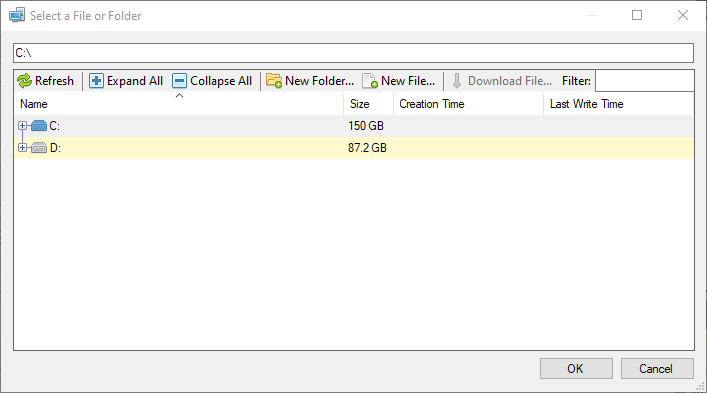
- Expression fx Icon
Clicking the blue fx icon to launch SSIS Expression Editor to enable dynamic updates of the property at run time.
Using Wildcard Characters
Wildcard characters * and ? can be used in the Source Path for the following connections:
- <Local File> (since v1.2)
- FTPS (since v1.2)
- SFTP (since v1.2)
- Amazon S3 (since v22.1)
- Azure Blob (since v22.1)
- Azure Data Lake Storage (since v22.1)
- Azure Files (since v22.1)
- Dropbox (since v22.1)
- Google Cloud Storage (since v22.1)
- Hadoop (since v22.1)
- OneDrive (since v22.1)
- SharePoint (since v22.1)
- WebDAV (since v22.1)
* matches any number of characters and ? matches a single alphabet in a specific position.
Advanced Filtering Page
The page consists of a grid in which filtering conditions can be configured
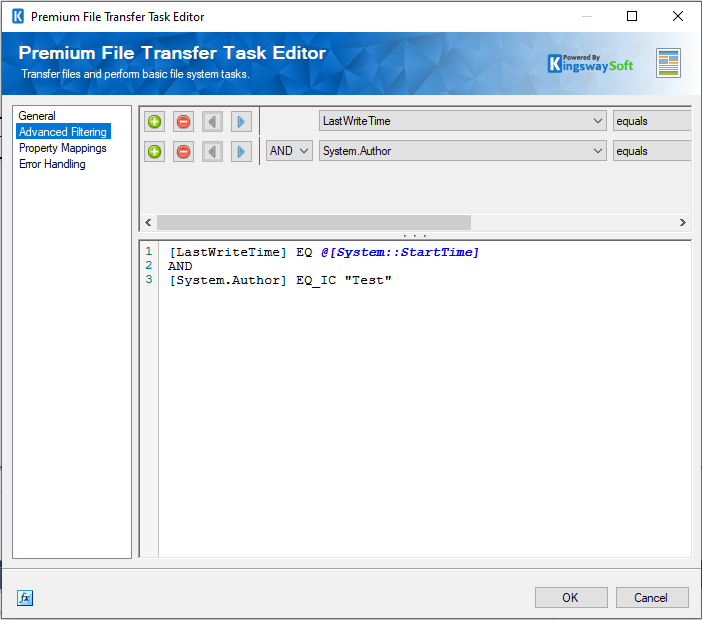
- Add condition (+): Adds a condition to be used in a query.
- Remove condition (-): Removes the condition that was added.
- Arrows: Use arrows to group the conditions.
- AND/OR: Specify AND or OR to create logical expressions of your conditions.
- Column: Select the column from the drop-down list which displays available columns for the filter action.
- Operator: Use query operator to specify how each input value in a clause must relate to the corresponding value in the properties
- Input Value: The Input Value for the filtering condition. Available options are Input Column, Static Value, and Variables.
Property Mappings Page
The page decides which fields to be mapped when copying or moving a file from Source to the target location.
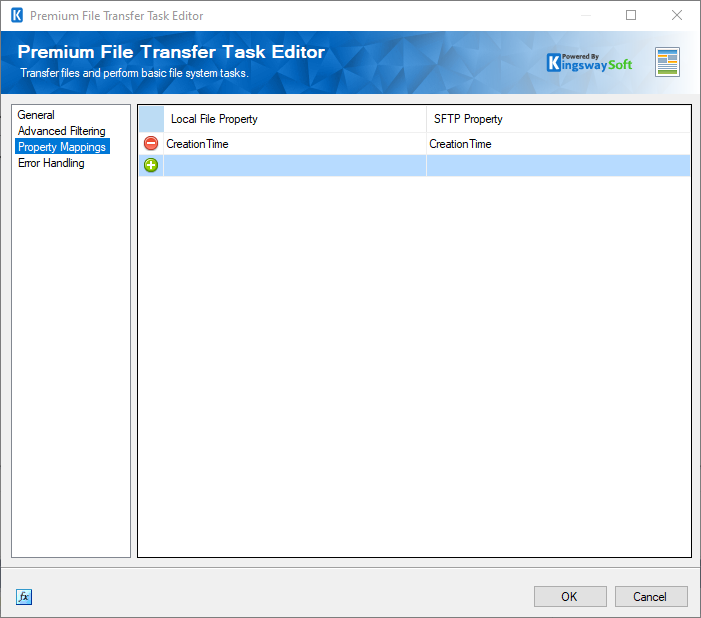
The grid will have column names named after the Source and the Target location. In the above example, the Source File location is local files, and the target is SFTP. Hence, you could map the available properties from the local file properties list to the SFTP properties for the file or folder being copied over or moved.
Error Handling Page
The Error Handling page can be used to handle errors.
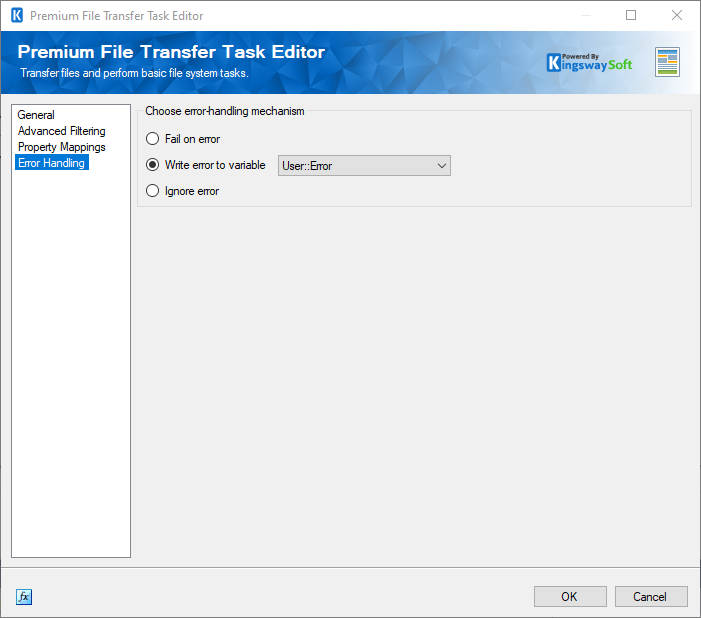
- Fail on error
-
When chosen, will fail the component on error.
- Write error to variable
-
Will write the error message to a variable.
- Ignore error
-
Ignores the error and continues the task.

